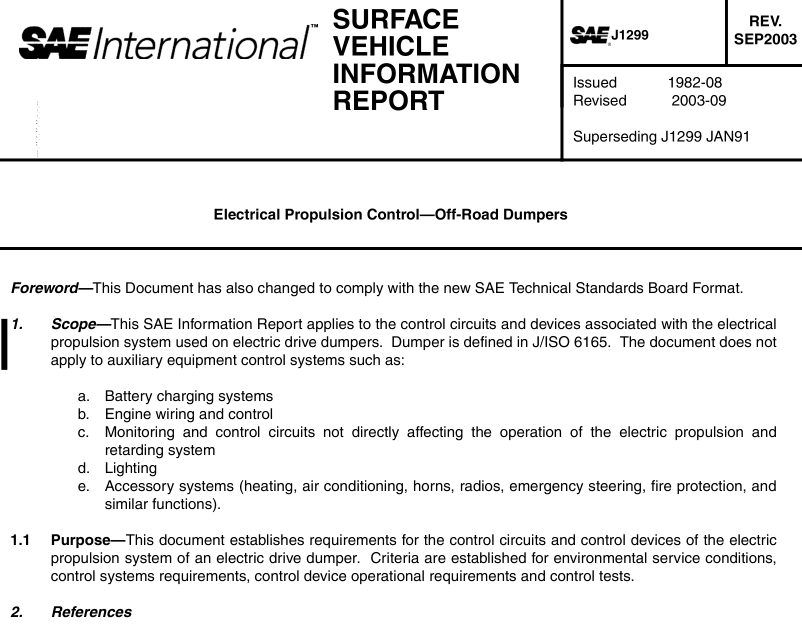SAE J1299:2003 pdf download Electrical Propulsion Control—Off-Road Dumpers
1. Scope—This SAE Information Report applies to the control circuits and devices associated with the electrical propulsion system used on electric drive dumpers. Dumper is defined in J/ISO 61 65. The document does not apply to auxiliary equipment control systems such as:
a. Battery charging systems
b. Engine wiring and control
c. Monitoring and control circuits not directly affecting the operation of the electric propulsion and retarding system
d. Lighting
e. Accessory systems (heating, air conditioning, horns, radios, emergency steering, fire protection, and similar functions).
1.1 Purpose—This document establishes requirements for the control circuits and control devices of the electricpropulsion system of an electric drive dumper. Criteria are established for environmental service conditions,control systems requirements, control device operational requirements and control tests.
2. References
2.1 Applicable Publications—The following publications form a part of the specification to the extent specified herein. Unless otherwise indicated, the latest revision of SAE publications shall apply.
2.1.1 SAE P UBLICATIONS —Available from the Society of Automotive Engineers, 400 Commonwealth Drive,Warrendale, PA 1 5096-0001
SAE J/ISO 6165 MAY99—Earthmoving Machinery – Basic Types – Vocabulary
3.Definition of Terms
3.1Dynamic Retarding—A method of slowing the dumper, or controlling its speed downgrade, by the controlled conversion of the dumpers kinetic energy to electrical power.A commonly used method is to dissipate thiselectrical power as heat through retarding resistors. These resistors may be:
a. Natural convection retarding resistors which dissipate heat to air circulated through the resistors bynatural convection; or
b. Forced convection retarding resistors which dissipate heat to air forced through the resistors by a blower or fan.
3.2Extended Range Retarding—The shunting out of a portion of the retarding resistors to maintain a high level
of dynamic retarding effort at low dumper speeds.
3.3Overspeed Retarding—The automatic application of dynamic retarding at,or above, a selected dumper speed.
3.4Routine Tests—Tests carried out on all electromechanical control devices and electronic assemblies prior to shipping by the supplier.
3.5Type Tests—Tests carried out on one or more electromechanical control devices and electronic assemblies of a new or modified functional design to determine conformance to design requirements.
3.6U—Represents rated value of supply voltage (nominal voltage).
4.Service Conditions一The control shall perform within the design limits at altitudes up to 3000 m above sea level and at ambient temperatures between -40 and +50 c.
Special arrangements shall be agreed upon between user and manufacturer to cover the case of serviceconditions more severe than those mentioned above.
5.Control System
5.1 Main Control Enclosure—When locating and/or constructing the main control enclosure, malfunctions due to the environment, dust,material spillage, fluid leakage,and/or rejected heat from other equipment shall beconsidered.
Equipment should be accessible for service, monitoring, and/or replacement.
5.2 Arrangement of Equipment—Components within the enclosure should be arranged in groups corresponding to voltage level of the circuit which they control. For example:
a.Traction power and retarding transmission systemsb. Excitation systems
c. Control systems
Individual components shall be identified indicating their function within the system. The designation shall bereadily visible on, or closely adjacent to, the component.
SAE J1299:2003 pdf download
